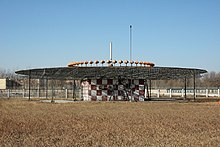Distance measuring equipment

Distance Measuring Equipment ( DME , English for distance measuring equipment ) is a radio station of the navigation radio service whose transmissions are intended to enable an aircraft to determine its distance in relation to a fixed reference point. In this case, by time of flight measurement the slant range of the aircraft determined by a DME ground station. The DME is based on secondary radar technology .
A DME is used in conjunction with a rotary radio beacon (VOR) or as a marker replacement for an ILS approach. A combined ground station with VOR transmitter and DME transponder is called VOR / DME or ILS / DME.
The technical principle of the DME is also used in the distance measurement part of a TACAN .
hardware
A DME system consists of a UHF transmitter / receiver query device (interrogator) in the aircraft and the UHF receiver / transmitter ( transponder ) on the ground.
Working principle
DME operate in the frequency range 962–1.213 MHz (divided into 126 X and 126 Y channels), which is assigned to the air navigation service for primary use.
To determine the distance, the on-board device sends pulse pairs with a random repetition rate to the ground station. These are answered after a fixed response delay (50 µs) and appear in the on-board receiver alongside the answers to queries from other on-board devices. From the mixture of all response signals, the on-board device filters out those that appear continuously with an (almost) constant time interval to its own query in the receiver and measures the time interval between sending the original signal and receiving the response. This time interval (minus the response delay) is the runtime of the radio waves from the on-board device to the ground station and back. By multiplying it by the propagation speed of electromagnetic waves , it is converted into the distance to the ground station.
This results in the following calculation to calculate the inclined distance to the DME station:
With
- t = measured running time in seconds
- c = speed of light in m / s (approx. 300,000,000 m / s)
- S = slope distance in m
To calculate the distance above ground, one applies the Pythagorean theorem :
With
- h = height above the DME antenna in m
- D = ground distance in m
The measured distance is displayed in nautical miles on the aircraft instrument in the cockpit .
Important for the use of DME -Information is understanding that not the distance above the ground, but from the triangular relationship of altitude resulting and removal on the ground slope distance (Engl. Slant range ) is displayed. The altitude is displayed as a distance directly above the station (→ 1 NM ≈ 6,076 ft ). The measurement error is approx. 45 to 100 m, with precision systems 50 m.
Instrument approach
If the DME is used in conjunction with a VOR or NDB for an instrument approach, the weather conditions must be better than the minimum conditions of a Category I instrument landing system .




